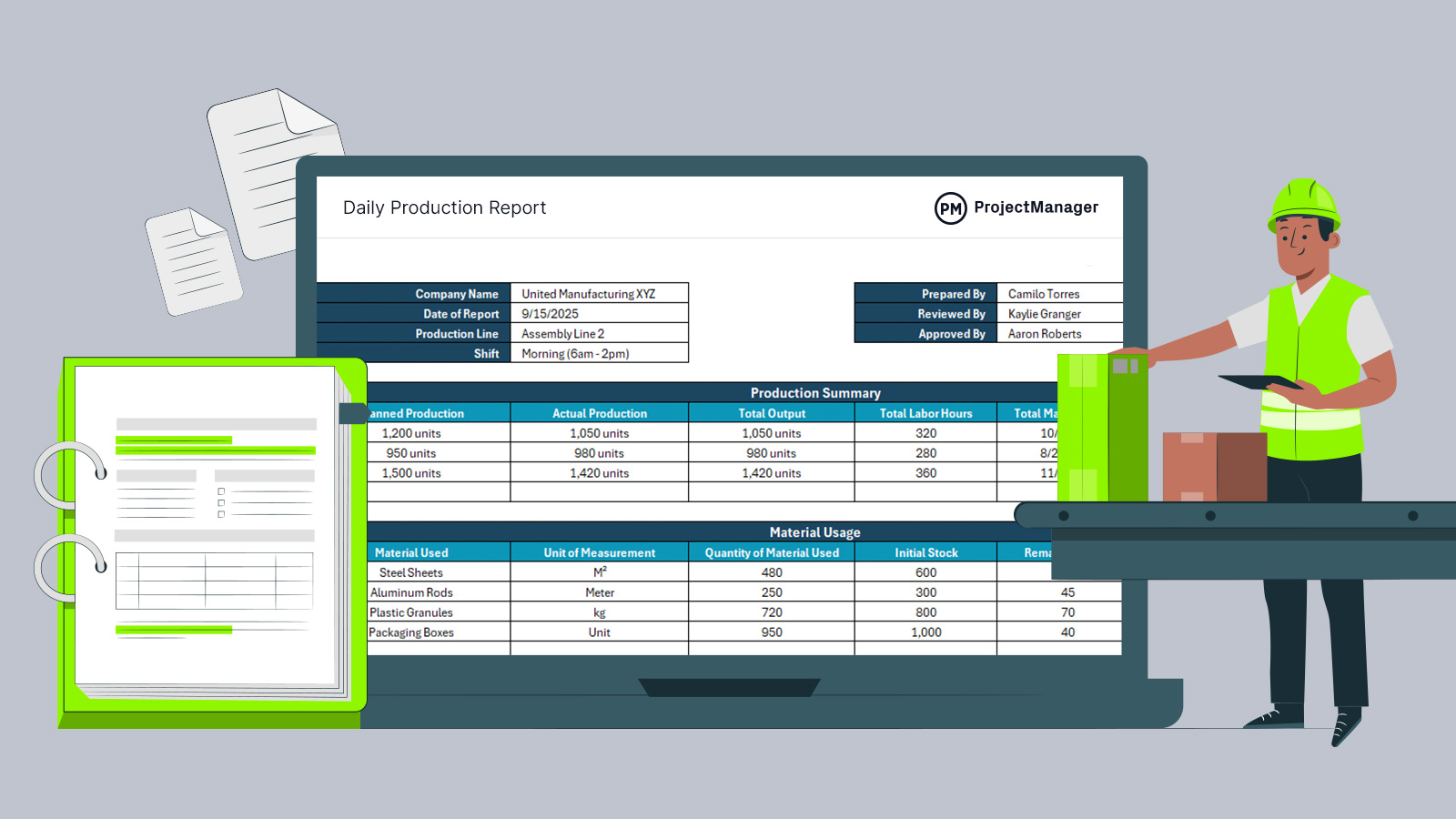A daily production report is one of the most essential tools for tracking manufacturing productivity. It provides a clear, day-by-day snapshot of what was produced, which resources were used and how the work progressed toward project goals. This document allows supervisors and managers to compare actual output against planned production targets, helping identify bottlenecks, downtime and inefficiencies before they impact the schedule.
In industries like manufacturing, a daily production report can capture key information such as labor hours, equipment usage, material consumption and completed tasks. This visibility makes it easier to monitor job site performance, control costs and communicate progress to stakeholders. When used on a factory floor, the daily production report is an indispensable part of keeping operations running smoothly and ensuring deadlines are met.
While a daily production report is valuable, managing production data with spreadsheets or static forms has limitations. Manually updating information increases the risk of errors, delays and data silos. Project management software automates much of this process, offering real-time updates, integrated communication and the ability to compare production data against schedules, budgets and resource plans in one place. This allows managers to act faster and make better decisions.
ProjectManager makes the daily production report process even more effective by giving teams a centralized platform for planning, tracking and reporting. With tools like workload charts, real-time dashboards and customizable reports, managers can see production progress at a glance and adjust schedules or resources instantly. The ability to switch between list, sheet, kanban and Gantt chart views provides full visibility into tasks and dependencies, helping teams stay productive and hit production targets consistently. Get started with ProjectManager today for free.
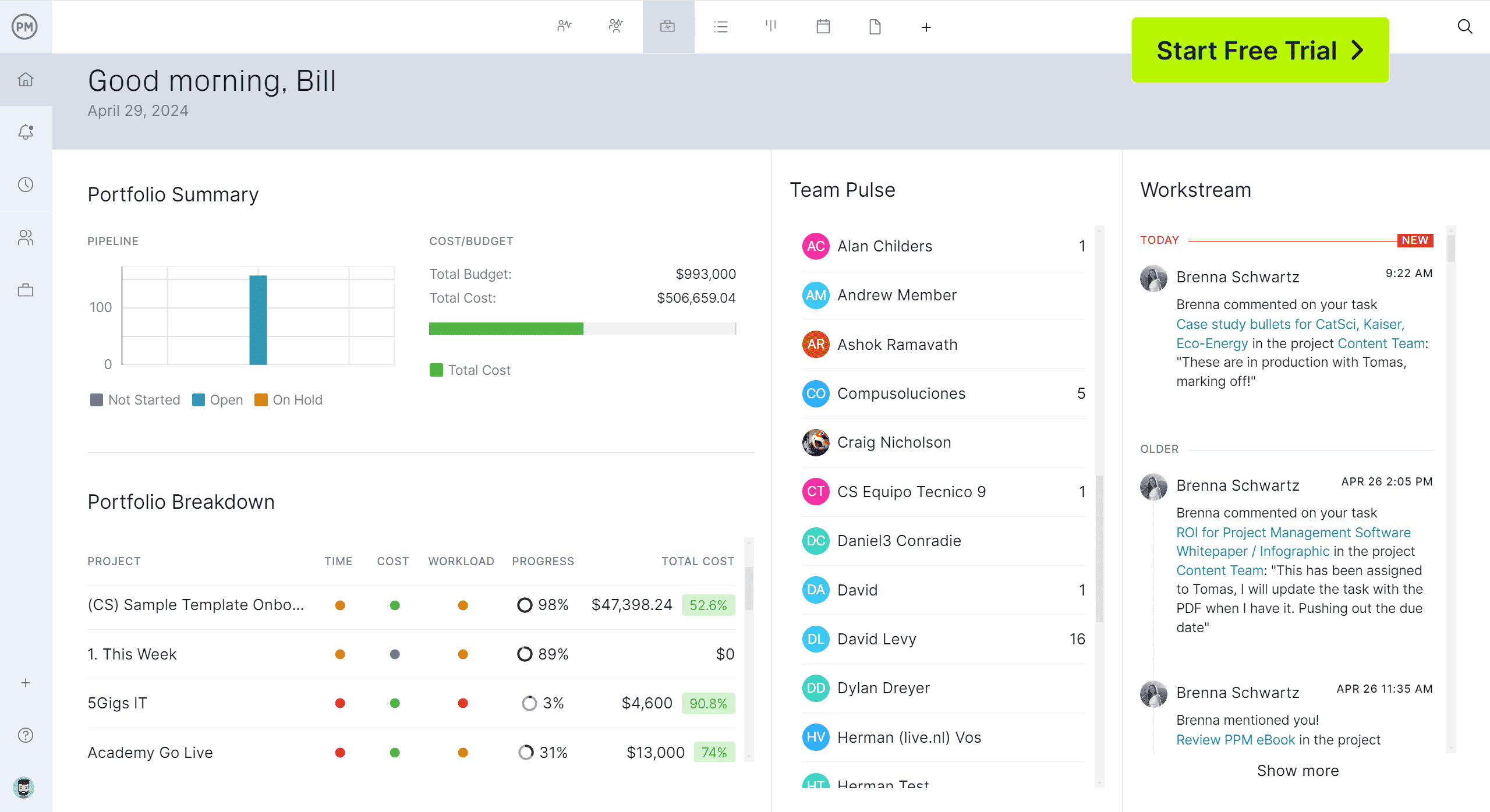
Why You Need a Daily Production Report
A daily production report is critical for maintaining visibility into day-to-day operations. It keeps managers and stakeholders informed about what tasks were completed, what resources were used and whether production targets are being met. This daily record allows teams to spot trends, identify problems early and take corrective action before small issues become larger setbacks. It also provides documentation for compliance, quality assurance and performance tracking.
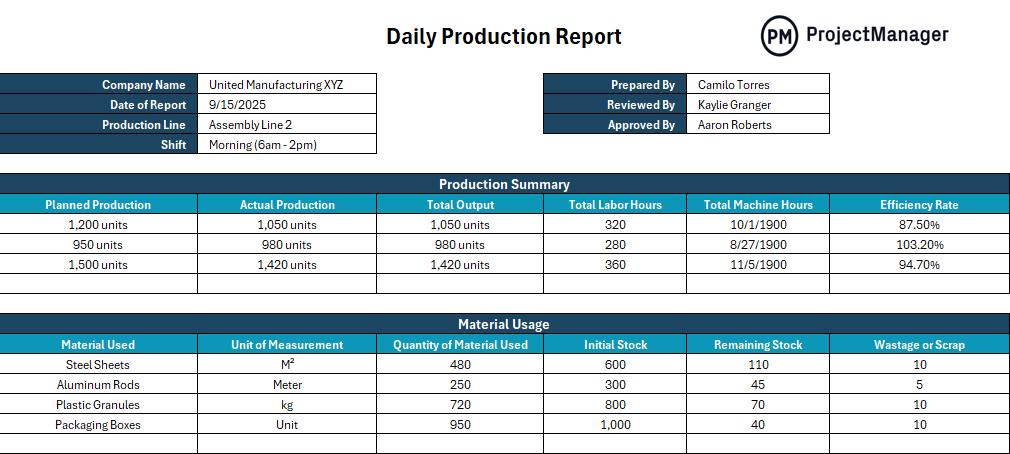
When to Use a Daily Production Report
Daily production reports should be used whenever consistent tracking of output, labor and resources is needed to keep projects on schedule and within budget. They are especially useful in manufacturing operations where production rates must be monitored closely to meet demand.
Manufacturing Operations
In a manufacturing facility, daily production reports document production output, machine downtime and material usage. This helps supervisors and line managers optimize workflows, reduce waste and maintain consistent product quality.
Who Should Use This Free Daily Production Report?
A daily production report is a valuable tool for anyone responsible for monitoring output, managing resources and keeping production on track. It provides the data needed to make informed decisions, address issues quickly and maintain consistent performance. Here are some of the key roles that can benefit from using this template:
- Production Manager: The production manager uses the daily production report to measure output against targets, assess efficiency and identify areas for process improvement. This helps keep production schedules aligned with demand.
- Shift Supervisor/Line Manager: Shift supervisors and line managers rely on daily reports to monitor worker productivity, track material usage and ensure production lines are running smoothly during their shifts.
- Maintenance Manager: Maintenance managers review the report to spot recurring equipment issues, track downtime and plan preventive maintenance to reduce disruptions and improve machine availability.
- Quality Control Manager: The quality control manager uses the data to check if output meets quality standards, identify defects early and work with production teams to resolve quality issues quickly.
- Operations Manager: Operations managers rely on daily production reports to get a high-level view of production performance, allocate resources effectively and communicate progress to stakeholders and leadership.
How to Use This Daily Production Report for Excel
This free daily production report template helps manufacturing teams track key performance indicators, compare planned output with actual production and analyze efficiency. It’s preformatted with sections for labor hours, machine hours, material usage, downtime and quality control so you can collect the data you need in one place.
Use this template to monitor production performance at the end of every shift. By logging production numbers, machine utilization and issues affecting output, you can spot bottlenecks early, improve planning and communicate important details to the next shift.
1. Compare Planned Production vs. Actual Production
Start by entering the planned production targets for the day or shift and the actual output achieved. This allows you to calculate efficiency and identify shortfalls so corrective actions can be taken quickly.

2. Log Labor Hours and Machine Hours
Record the total number of labor hours worked and machine hours used. Tracking this data helps determine productivity, calculate cost per unit and schedule maintenance based on machine runtime.

3. Measure Material Usage and Remaining Inventory
Enter the quantity of raw materials used, the starting inventory and the remaining stock. This provides visibility into consumption rates and highlights when reorders are necessary to prevent stockouts.

4. Document Planned and Actual Machine Downtime
Log both scheduled downtime for maintenance and unplanned downtime due to equipment failures. This data can be used to analyze lost production time and develop strategies to reduce downtime in the future.

5. Assess the Quality of Production
Record defective units, scrap or rework. Tracking quality issues over time helps identify patterns, pinpoint process issues and improve overall production quality.

6. Log Safety Issues
Document any incidents, near-misses or unsafe conditions observed during the shift. Capturing safety data is critical for compliance and for taking steps to prevent future accidents.

7. Document Production Bottlenecks and Challenges
Describe any production issues, bottlenecks or supply chain delays that impacted performance. This ensures the next shift is aware of potential challenges and can plan accordingly.

8. Write Instructions for Next Shift
End the report with notes or recommendations for the next shift. Include key updates, special instructions and any ongoing issues that need to be monitored or resolved.

Free Related Manufacturing Templates
A daily production report is just one of many tools manufacturing teams use to stay efficient and keep operations running smoothly. If you want to improve production planning, inventory tracking and material management, these free manufacturing templates can help. Each one is designed to give you an organized, easy-to-use format that saves time and improves accuracy.
Inventory Template
Download this free inventory template to track stock levels, item descriptions, locations and reorder points. It’s ideal for monitoring raw materials, work-in-progress items and finished goods to avoid stockouts or overstock situations. This template helps you maintain visibility across your entire inventory and plan purchases more effectively.
Production Schedule Template
Use this free production schedule template to help you plan daily, weekly or monthly production runs by assigning tasks, setting deadlines and mapping out dependencies. It’s a simple way to allocate resources, balance workloads and make sure production meets demand without overloading equipment or labor.
Bill of Materials Template
A bill of materials template is essential for manufacturers who need to outline the raw materials, components and assemblies required to produce a finished product. This template ensures that nothing is missed during procurement or production and makes it easier to calculate total costs and plan material requirements accurately.
How ProjectManager Helps With Production Projects
Managing production projects involves balancing people, equipment and materials while ensuring you hit deadlines and maintain quality standards. Static tools, like a daily production report, can capture what happened, but they don’t help you act on issues in real time. ProjectManager solves this by providing live visibility into every part of production, so you can track progress, spot bottlenecks and adjust quickly to stay on target.
Streamline Workflows with Multiple Project Views
Different teams need different perspectives to work effectively. ProjectManager gives you multiple project views—such as list, kanban board and calendar—so everyone can work in the way that suits them best. Production managers can map tasks and due dates on a timeline, while line supervisors can visualize progress on a simple task list. This flexibility keeps the whole operation aligned without forcing everyone into one rigid view.
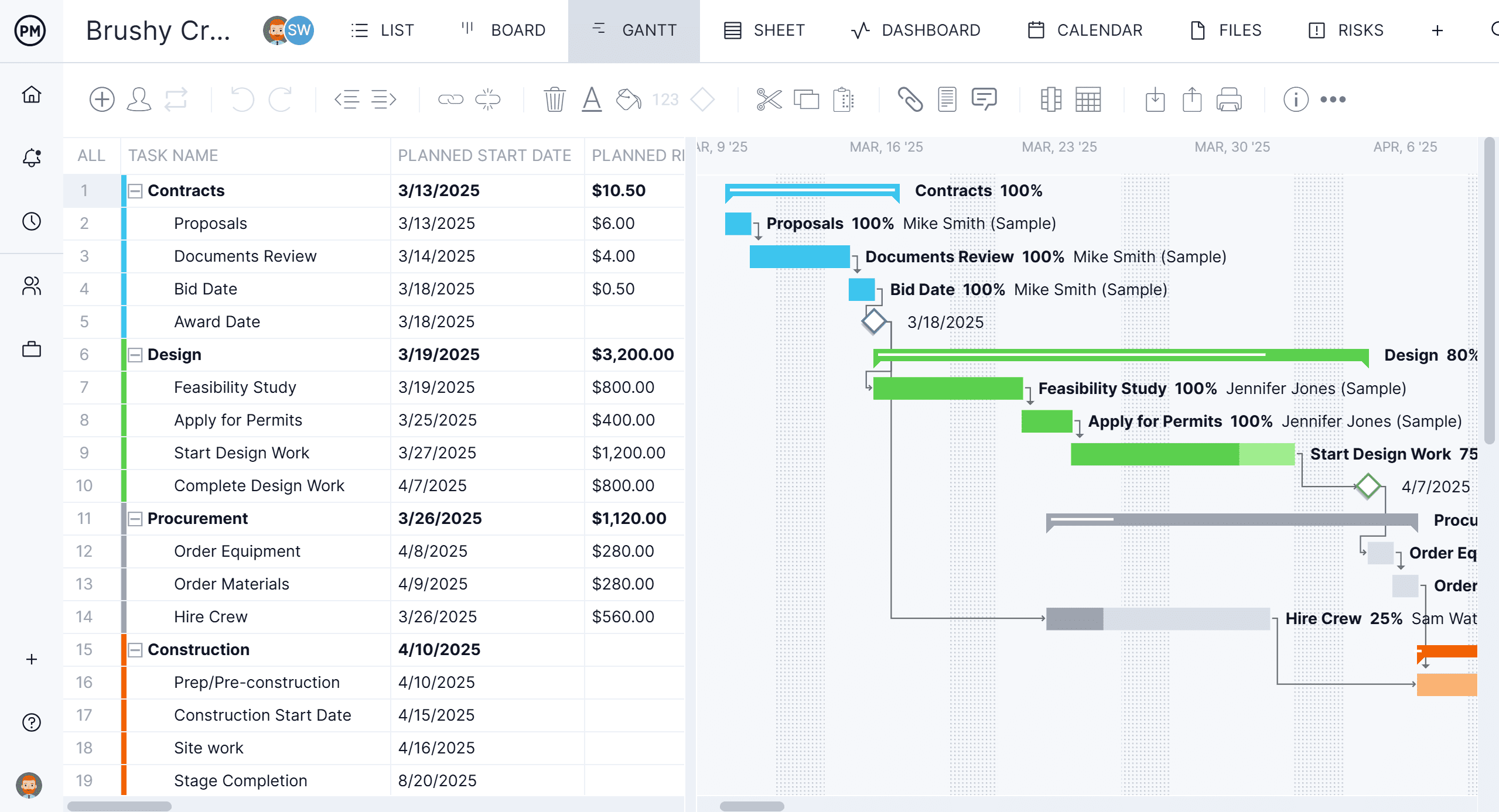
Optimize Workloads With Resource Management Tools
Balancing labor, machine time and materials can be a challenge with just a spreadsheet. ProjectManager’s resource management tools let you see team availability, assign tasks based on capacity and avoid overloading workers or equipment. The color-coded workload chart makes it easy to spot imbalances at a glance and reallocate work before it causes delays. Combined with our cost tracking features, you can monitor labor and material expenses in real time to prevent budget overruns.
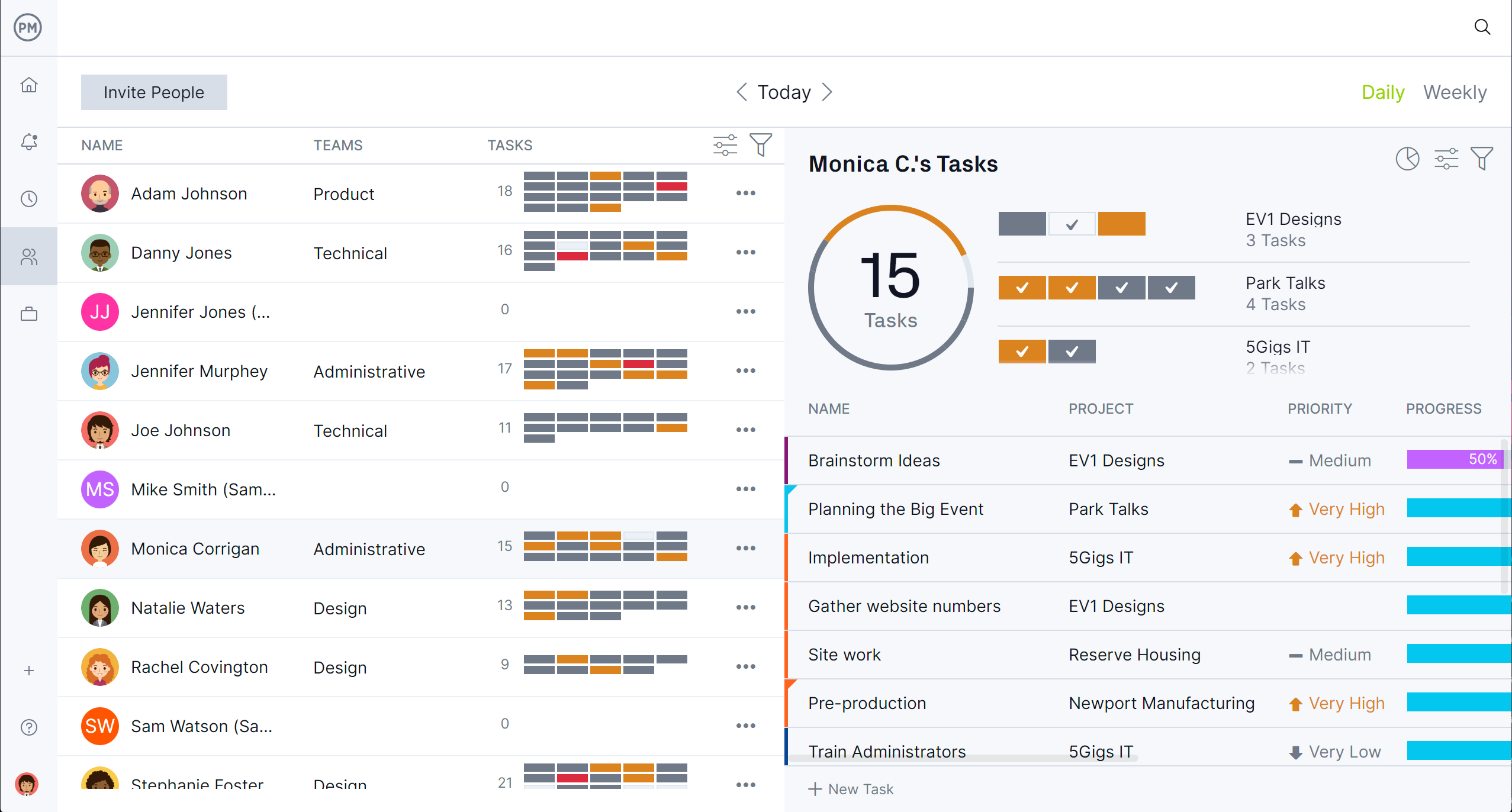
Related Production Management Content
There’s more to production than a daily production report, as important as that might be. For readers who are curious to learn more about this topic, below are some links to recently published articles about production management, goals and much more.
- Production Management: Importance, Scope & Functions
- 30+ Production Goals: Hit More Production Targets
- 20 Production and Manufacturing KPIs & Metrics
- Production Tracking: Monitoring the Success of Your Manufacturing Process
- 15 Top Methods of Production
- How to Create a Master Production Schedule (MPS)
ProjectManager is online project and portfolio management software that connects teams, whether they’re in the office or out in the field. They can share files, comment at the task level and stay updated with email and in-app notifications. Get started with ProjectManager today for free.
